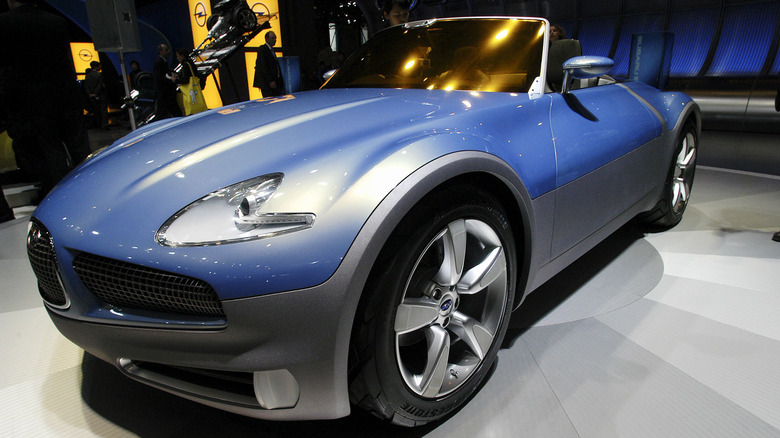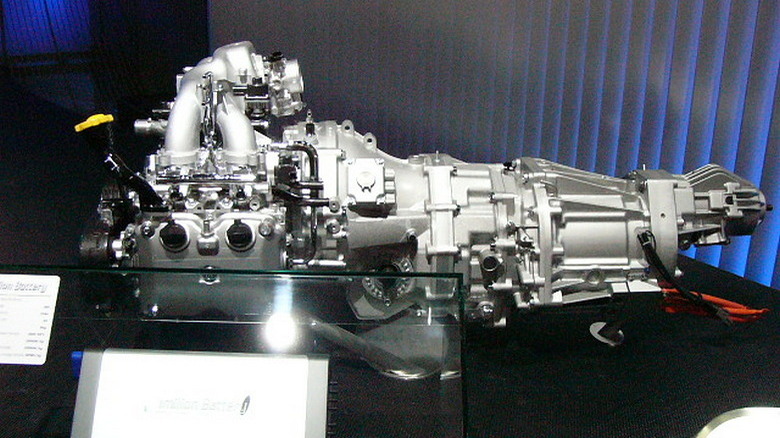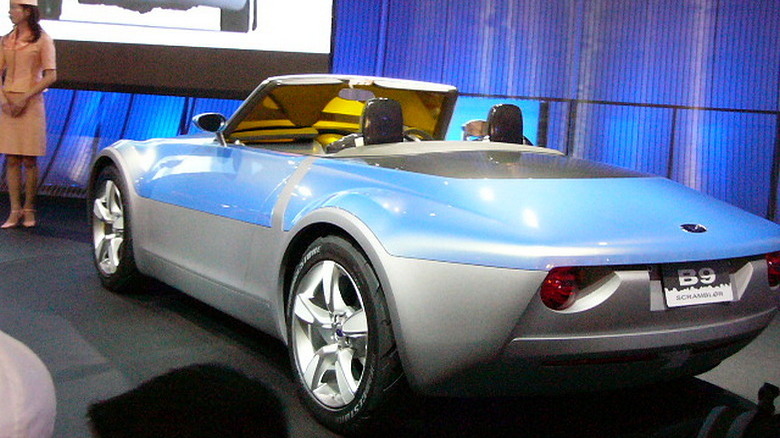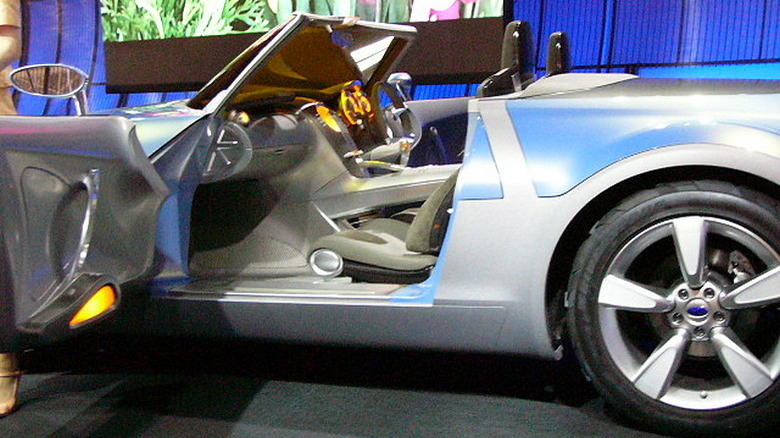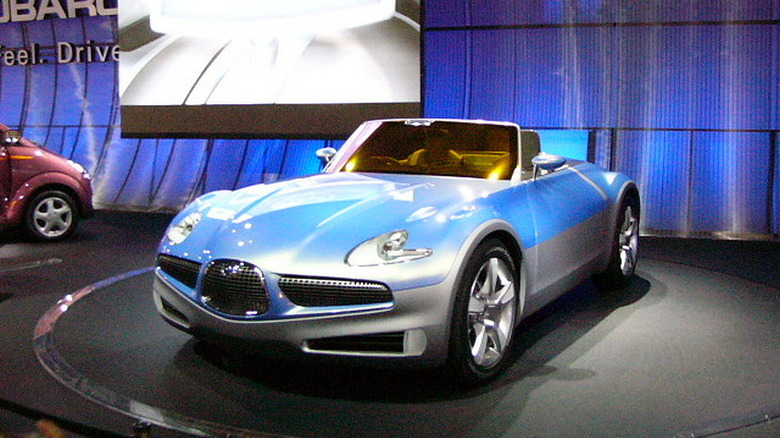5 Tech Innovations That Put The Subaru Scrambler Ahead Of Its Time
First unveiled in late 2003, the Subaru B9 Scrambler (also known as the B9SC) was a concept car that sported a much different look than most car design aesthetics of that era. Its airplane-shaped, aggressive-looking front grill paid homage to Subaru's parent company, Fuji Heavy Industry, which built fighter planes in World War II. It was also a convertible, which was pretty unusual for the company as it had only produced a handful of convertibles throughout its existence.
The first and most obvious tech innovation for the B9 Scrambler is the design and materials of its outer shell. This two-seater Subaru roadster had sleek and swooping curves that would go on to influence body design across the automotive landscape for years to come. It also had a scratch and dent-resistant body with hard plastic lower panels along with protective paint on the upper body that made sure small rocks and other debris wouldn't scrape up the paint job. From the outset, even just by looking at it, it was clearly a very forward-thinking car, and other car companies immediately took notice.
Sadly, for all its glory, Subaru realized it couldn't produce the vehicle en masse due to high production costs, so it never made it into circulation. Still, it was groundbreaking in many ways, from its sleek look down to its engine and unique suspension. Read on to check out the rest of the tech innovations that made clear the Subaru B9SC was ahead of its time.
Pioneering hybrid technology
At a time when hybrid technology was in its infancy, the B9 Scrambler was extremely innovative. It offered both a 134-horsepower electric motor and a 2.0-liter 138-horsepower flat-four combustion engine that worked in tandem and kept the car more eco-friendly. In what Subaru called a "Sequential Series Hybrid Electric Vehicle (SSHEV)," the electric motor powered the car from 0–50 mph, meaning that when tooling around town, you wouldn't be wasting gas.
But once you got out on the highway and got past 50 mph, the gas engine would kick in seamlessly through the use of a transmission with a two-way clutch. The gas engine would also kick in if you needed to accelerate quickly, whether you were speeding up to get on the highway or driving up steep hills.
This early hybrid technology both consumed less gas and provided for lower exhaust emissions than most other cars. In an effort to conserve energy, the gas engine would also act as a charger for the car's batteries. At a time when fears were beginning to emerge about climate change, this hybrid concept was exceedingly forward-thinking and certainly informed many of Subaru's future hybrids.
[Featured image by 160SX via Wikimedia Commons | Cropped and scaled | CC BY-SA 3.0]
Safety features way before their time
Along with the high-tech engine that powered the B9 Scrambler, Subaru innovated heavily with the safety features of the roadster to make sure drivers stayed safe. It used what the company called an Active Driving Assist (ADA) system.
The ADA featured both front and rear-facing cameras; in the front, the cameras were built into the top of the windshield frame, and in the rear, they were mounted near the license plate. It had a radar system in the front grill that could detect when cars were braking quickly so the driver had time to react.
The Scrambler also had "smart" cruise control using the radar to judge the car's speed in front of it and adjust speed to compensate. Like many of today's cars, it also had a lane deviation system, letting the driver know when they had started to drift outside the lines. With most newer model vehicles adopting features like these, it's easy to see that the B9 Scrambler was at the forefront of safety technologies back in 2003.
[Featured image by 160SX via Wikimedia Commons | Cropped and scaled | CC BY-SA 3.0]
Infotainment in the beginning
In today's cars, vans, and trucks, it's common for there to be at least one screen mounted on the dashboard to access tools and other apps that are at your fingertips. But back then, it was a fairly new concept. The B9 Scrambler had a touchscreen interface providing various navigation controls that were not found in most vehicles, but it was very early for this technology. This is to say, it wasn't nearly as intuitive as what we have today.
It could provide trip navigation, giving you turn-by-turn directions to get you where you need to go. It could show you your coordinates by longitude and latitude, which isn't something you see (or really need) in today's in-car nav systems. It didn't have Bluetooth to connect your phone, but–to be fair–in 2003, that phone was not a smartphone anyway, as the iPhone wasn't released until 2007. Still, the Scrambler was ahead of its time in putting navigation on the dashboard and influenced what would become a much more useful tool in the future.
[Featured image by 160SX via Wikimedia Commons | Cropped and scaled | CC BY-SA 3.0]
Versatile suspension system
Another cool feature that set the Scrambler apart from the competition was its advanced pneumatic suspension system. The symmetrical all-wheel drive (true to Subaru form) literally rode on air. With this setup, it could counteract the centrifugal force as you went into corners and self-level out much quicker as you came out of them.
It could also electronically adjust the drive height, making it great not just for performance on streets and highways but also in rough weather and off-road conditions. In fact, the drive height could adjust between 150 and 200 millimeters, compensating automatically for whatever terrain it was driving on.
All-in-all, the Suburu B9 Scrambler was ahead of its time in many ways, from its sleek look to the innovative technologies the company implemented throughout the car. While this technologically groundbreaking concept car never made it to mass production, it left an indelible mark on the automotive world, influencing eco-friendly vehicles for years to come.
[Featured image by 160SX via Wikimedia Commons | Cropped and scaled | CC BY-SA 3.0]
